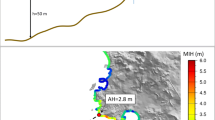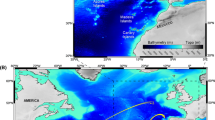Abstract
A method is derived to forecast theextreme heights of later waves in Pacific-widetsunamis, for locations in the vicinity of real-timereporting tide gages. The forecast for wave peaks hasthe form ηF(t) = ηB(t) + ηe(t),where ηe = Aσ exp [- (t - to)/τ ]. Here, the forecast begins attime t = to, which is 4 h after tsunamidetection at a tide gage, σ is the standarddeviation of tsunami-band fluctuations observed in the2-h time interval before the forecast begins,ηB is a background water level predictionthat includes the tides and lower frequencyoscillations, τ = 48 h is an e-folding decayconstant, and A = 3.0 is a constant coefficient.Placing a minus sign in front of ηe providesa forecast for wave troughs. This form for theforecast, and the values of the parameters, arejustified using probability theory and Monte Carlosimulations based on 3000 synthetic tsunami timeseries. The method is then tested successfully (i.e.,agreement within 0.5 m) against six past Pacific-widetsunamis, as observed at U.S. tide gages. These casestudies include the five major tsunamis to produceloss of life and/or substantial damage to U.S. coastalcommunities during the Twentieth Century. The sixthstudy is the 1994 Shikotan tsunami, which is thelatest Pacific-wide tsunami to trigger tsunamiwarnings for U.S. regions. Algorithms for detectinglocal tsunami onset and generating forecasts are givenin an appendix, together with a description of thewavelet method used to generate the synthetic tsunamiseries.
Similar content being viewed by others
References
Cummins, P. R., Hirano, S., and Kaneda, Y.: 1998, Refined coseismic displacement modeling for the 1994 Shikotan and Sanriku-oki earthquakes, Geophys. Res. Lett. 25(17), 3219-3222.
Van Dorn, W. G.: 1984, Some tsunami characteristics deducible from tide records, J. Phys. Oceanogr. 14(2), 353-363.
Van Dorn, W. G.: 1987, Tide gage response to tsunamis. Part II: Other oceans and smaller seas, J. Phys. Oceanogr. 17(9), 1507-1516.
González, F. I., Satake, K., Boss, E. F., and Mofjeld, H. O.: 1995, Edge waves and non-trapped modes of the 25 April 1992 Cape Mendocino tsunami, Pure Appl. Geophys. 144(3/4), 409-426.
Lander, J. F. and Lockridge, P. A.: 1989, United States Tsunamis (Including United States Possessions) 1690-1988, NOAA NGDC Publ. 41-2, Boulder, CO.
McGehee, D. D. and McKinney, J. P.: 1997, Tsunami detection and warning capability using nearshore submerged pressure transducers-Case study of the 4 October 1994 Shikotan tsunami, In: G. Hebenstreit (ed.), Perspectives on Tsunami Hazard Reduction, Kluwer, Norwell, MA, pp. 133-143.
Miller, G. R., Munk, W. H., and Snodgrass, F. E.: 1962, Long-period waves over California's borderland. Part II: Tsunamis, J. Mar. Res. 20(1), 31-41.
Mofjeld, H. O.: 1992, Subtidal sea level fluctuations in a large fjord system, J. Geophys. Res. 97(C12), 20,191-20,199.
Mofjeld, H. O., Foreman, M. G. G., and Ruffman, A.: 1997a, West Coast tides during Cascadia subduction zone tsunamis, Geophys. Res. Lett. 24(17), 2215-2218.
Mofjeld, H. O., González, F. I., and Newman, J. C.: 1997b, Short-term forecasts of inundation during teletsunamis in the eastern North Pacific Ocean, In: G. Hebenstreit (ed.), Perspectives on Tsunami Hazard Reduction, Kluwer, Norwell, MA, pp. 145-155.
Mofjeld, H. O., González, F. I., and Newman, J. C.: 1999, Tsunami prediction in U.S. Coastal Regions, In: C. Mooers (ed.), Coastal Ocean Prediction, AGU, Washington, D.C., pp. 353-375.
Pacheco, J. and Sykes, L. R.: 1992, Seismic moment catalog of large shallow earthquakes, 1900 to 1989, Bull. Seismol. Soc. Am. 82, 1306-1349.
Percival, D. B. and Mofjeld, H. O.: 1997, Analysis of subtidal coastal sea level fluctuations using wavelets, J. Am. Stat. Assoc. 92(439), 868-880.
Press, W. H., Teukolsky, S. A., Vetterling, W. T., and Flannery, B. P.: 1992, Numerical Recipes: The Art of Scientific Computing (2nd edn), Cambridge, MA.
Titov, V. V. and González, F. I.: 1999, Implementation and Testing of the Method of Splitting Tsunami (MOST) Model, NOAA Technical Memorandum ERL PMEL-112 (PB98-122773).
Titov, V. V., Mofjeld, H. O., González, F. I., and Newman, J.: 1999, Offshore Forecasting of AASZ Tsunamis in Hawaii, NOAA Technical Memorandum ERL PMEL-114.
Tanioka, Y., Ruff, L., and Satake, K.: 1995, The great Kurile earthquake of October 4, 1994 tore the slab, Geophys. Res. Lett. 22(13), 1661-1664.
Author information
Authors and Affiliations
Corresponding author
Rights and permissions
About this article
Cite this article
Mofjeld, H.O., GonzáLez, F.I., Bernard, E.N. et al. Forecasting the Heights of Later Waves in Pacific-Wide Tsunamis. Natural Hazards 22, 71–89 (2000). https://doi.org/10.1023/A:1008198901542
Issue Date:
DOI: https://doi.org/10.1023/A:1008198901542




